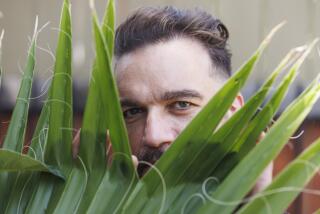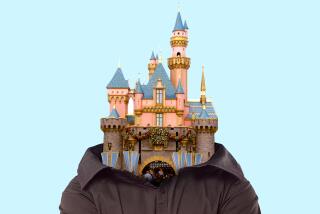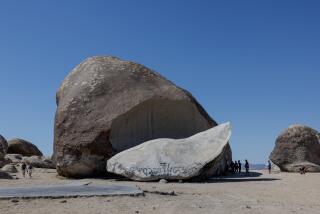A Page Right Out of History
- Share via
BEDROCK CITY, Ariz. — We returned to Bedrock to make sure it’s real.
On our one previous visit, we’d been like most tourists, hurtling south on Highway 64 after visiting the Grand Canyon. Like most tourists, we’d seen the signs for the Flintstones’ Bedrock City. Unlike the vast majority, we pulled through its giant concrete bone entryway. Exhausted, we stopped next to the cartoon-cave entrance, alone in the vast gravel parking lot.
Pam and Bobby, a baby then, dozed in the car, kept company by a scratchy audio loop of the Flintstone characters that issued from a hidden speaker. Half-asleep myself that first time, I ushered Ashley and Emily through the gift shop and into an unsettling dreamscape.
I’ve since decided that what we stumbled upon was a modern mythic shrine to the American family.
This time we pull our RV into Flintstones Campground around midnight and sleep as if the star-filled desert sky has sucked us into peaceful oblivion.
Early the next morning, after a 50-cent shower in a cavelike bathroom and a 5-cent cup of coffee at Fred’s Diner, I enter the park on my own while Pam and the kids bicycle around the campground.
It’s just as I remember it: a purple, green, yellow, red and blue pseudo-Stone Age ghost town, a pop and folk art Stonehenge fighting the overwhelming beauty of Arizona’s high desert for attention.
Like a crypto-archeologist alone in prehistory, I pass a sculpted likeness of Fred, a caveman car and a rounded hut labeled “Goatasaurus.” Two bearded creatures poke through the fence and let loose lonesome bleats.
I step away, and again the crunch, crunch, crunch of my boots on red gravel is the only sound.
Then, in the distance, I hear Wilma and Betty plotting to straighten out their ever-errant spouses. I step into the big dome of Bedrock Theater and part dusty, leopard-skin curtains. The cavernous room is empty. A blank movie screen flickers white as the characters continue a conversation recorded in the cartoon’s 1960s prime time heyday.
It was in that simpler time that a group of investors obtained licensing rights to the Hanna-Barbera characters and opened a Flintstones park in Custer, S.D.
In 1972, one of those investors, Woodrow Speckels, sold his stake and leased 40 acres of land 25 miles south of Grand Canyon National Park. His son, Francis, a South Dakota building contractor, agreed to take on the challenge of sculpting another Flintstones park.
Francis’ wife, Linda, was a young mother of five girls at the time. She never thought twice about heading farther West.
“You’ll move anyplace with the man you love,” she says, as the two of us sit at a concrete table just inside the park. “As long as you have your family and husband, you’re happy. We made the trip in two days, in a Buick Limited packed full of kids and clothes.”
When they arrived, the site was barren. “Not one tree on it.”
The stretch of highway that became Bedrock was just a gas station, a rock-hound shop and small Air Force outpost. By the time Linda and the girls arrived, Francis was already at work shaping the park’s goofy buildings and massive, bone-capped walls from angle iron and wire mesh. As he plastered the frames with gunite, the cartoon-inspired vision rose from the desert like a mirage.
“He was an artist at what he did,” Linda says.
*
The family was to stay only until they finished the park. They meant to return to South Dakota, a plan that suited Linda fine, because the desert didn’t.
“I like green grass and broad-leaf trees,” she says. “It has taken me 20 years to get used to Arizona.”
Those first years were tough. Francis’ parents divorced in 1974, and when his mother was awarded the family’s share of the business, Francis bought it from her. Slowly, his family--kids, grandparents, in-laws--were drawn into the venture, reluctant pioneers in the early days of the family entertainment boom.
“It’s the family farm,” Linda says, brushing back a strand of red hair teased by an increasingly assertive wind.
But this frontier, too, had its hardships. No sooner had the family opened the park’s doors than the oil embargo brought tourist traffic to a crawl. They had to truck in all their water. And the desert, eager to reclaim its turf, fought back with thistles and tumbleweeds. More recently, graffiti has appeared.
“It has never been as lucrative as the one in South Dakota,” Linda says of her park. “It has a different atmosphere.
“We’re an overflow attraction, not a major destination. . . . If the Grand Canyon campgrounds get full, our campground gets busy. Get rich? We didn’t have that mentality. We wouldn’t know how to do that. What we had was perseverance. Or ignorance.”
*
Gina, the youngest daughter, joins us. Now 26, she has worked at the park for two decades. When she was 6, she’d slap buns onto the grill as her grandmother flipped the hamburgers at Fred’s Diner. She played house in the Flintstones’ cave dwellings with her older sister Heidi.
“Some of the children have resented what it took to make this business,” Linda says. “We really depended on the family.”
The girls rode a bus 30 miles to school in Williams. Friendship, let alone dating, was a task. Summer vacation meant waiting tables, painting Dino, pulling weeds.
But the hard work and isolation also cemented the clan.
Then, in 1989, a doctor in Flagstaff told Francis he had lung cancer. “Before he died--six months later, on Easter Sunday--he told me, ‘If you have one problem, get out of there.’ Well, we’ve had many problems. But we kept at it.”
By now the wind is screeching through the concrete village, carrying the voices of the Flintstones and the Rubbles and the chatter of a flesh-and-blood family that has paid $5 a head to enter.
That family slides down Dino’s long green neck. They wait by a little tram, and eventually a worker shows up and drives them through a 40-foot volcano, where distinctly sub-Spielbergian pterodactyls reel round and round to rumbling sound effects.
“I started working on this garden as a tribute to my husband,” Linda says, her eyes focusing on a small pond and fountain. “It’s a challenge to make anything grow here. This was the ugliest part of the park. The first year, I planted 2,000 tulip bulbs.”
I’ve been vaguely aware that the nook in which we sit is different. Now I look around and realize that this is Linda’s gesture of defiance to the surrounding red dust--an Eden of trees, shrubs and blossoming flowers.
She spins a lipstick-stained plastic cup. Gina knows what’s coming. Both mother’s and daughter’s eyes go teary.
On Thanksgiving three years ago, the whole extended family had gathered for its traditional dinner at the large house Francis built next to the park. The grandkids watched satellite television. The adults gossiped. Only Heidi, who was driving in from Flagstaff, was late.
“We waited dinner, thought maybe she stopped to visit friends,” Linda says. “At 6:30, I was whipping cream for the pumpkin pie when I saw headlights in the driveway.”
A highway patrolman asked Linda to step outside. He told her that Heidi had driven her Honda Accord off the road along a boulder-strewn stretch of Highway 17, and died as passersby held her.
Linda wailed and beat on the patrolman. He repeated the news to the gathered clan and left.
“We all fell silent for a moment and then we cried,” Gina recalls.
“We sat and held each other all night,” Linda says.
The plastic cup squeaks on the table. The wind wails.
“My dream was that one of the children would take this over,” Linda says. “But they’ve pretty much told me, ‘Get on with your life. Have a life.’ They’re not interested in operating it. So after Heidi’s death, I set a goal to get out of here in the year 2000.”
I ask her if deep down she resents the Flintstones and the Rubbles, the happy cartoon families that tied her to such a hardscrabble existence.
“No, no,” she says. “We’re a lot like the Flintstones. Humble. Hard-working. And my husband really was a lot like Fred: gruff but affectionate.”
She smiles. “No, the Flintstones, they’re one of the few things that’s still good in America.”
* Thursday: Adopt a Grandparent.
More to Read
Sign up for The Wild
We’ll help you find the best places to hike, bike and run, as well as the perfect silent spots for meditation and yoga.
You may occasionally receive promotional content from the Los Angeles Times.






